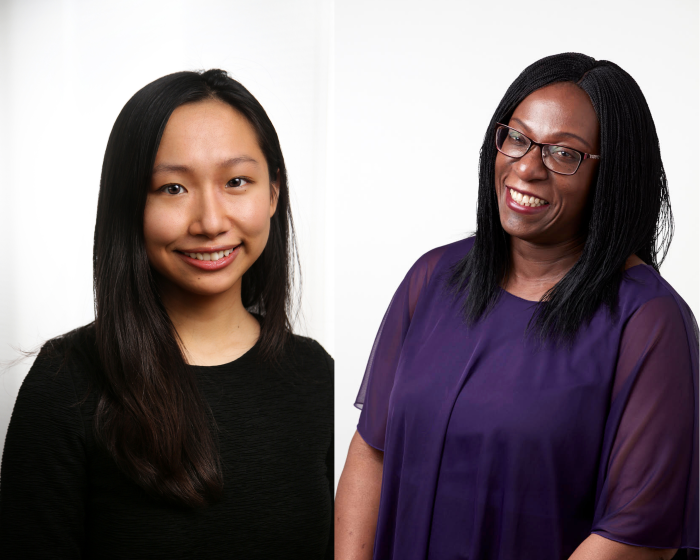Ngozi Lyn Cole and Bonnie Chiu: Two years later
26 October 2022
26 October 2022

Bonnie Chui (left) and Ngozi Lynn Cole (right)
In September 2020, near the start of our work with Lloyds Bank Foundation on their racial equity journey, we blogged about our hopes for this initiative. The Foundation had decided to dedicate at least 25% of their budget to charities led by and working with people from Black, Asian and Minority Ethnic Communities. This was based on the seismic reckoning that arose from the Covid-19 pandemic and the Black Lives Matter movement, as well as some internal reckonings.
Two years ago, we set a number of ambitions for the Foundation. We wanted to see them do four things:
We feel proud that the Foundation has made progress against most of these ambitions largely thanks to the hard work of the whole team. The progress on racial equity has broadened to encompass Equity, Diversity and Inclusion (EDI) more fully. The Foundation also no longer needs our advice on a day-to-day basis, as the work on EDI continues to be embedded across the Foundation.
Importantly, we’re confident that the Foundation is truly committed to continuing on this journey.
As a member of Foundation staff said to us “the work is never done”. We agree – more work is needed to address generations of injustice and the harm done to the people and communities as a result
Looking forward, here are our three reflections on the Foundation’s new strategy and suggestions for other foundations who may see the need to embark on a similar journey.
Recognise that to truly address inequity, you will need to consider every single aspect of your work. The Foundation started with a very precise problem, based on their own data – application rates of Black, Asian and minority ethnic-led organisations (26%) were lower than wider applications (35%). We were recruited to address this specific problem, and we created a racial equity portfolio, which led to “a fourfold increase in the share of our grants going to charities led by-and-for Black, Asian and minority ethnic communities”, as stated in the learning report.
This led to them awarding 38% of their funding to Black, Asian and minority ethnic communities, smashing their 25% ambition. Despite this specific focus, the Foundation never lost sight on the wider EDI ambitions. Starting small enabled the Foundation to build a sense of confidence and mission, while easing the whole organisation into EDI. In our experiences, having worked with over 10 Foundations in the past two years on EDI, many Foundations feel overwhelmed by the scale of the EDI challenge, and not knowing where to start often means not starting at all.
As a member of Foundation staff said to us “the work is never done”. We agree – more work is needed to address generations of injustice and the harm done to the people and communities as a result. There were moments of wavering, after the Foundation smashed the racial equity target, and upon some challenges on the legality of positive action, about whether the ringfencing for Black and minoritised-led organisations should be dropped. We’re pleased that they stood firm.
We understand the concerns outlined by Ubele in their Booksa Paper that funders may not be committed to racial justice work in the long term and suspicion that higher levels of funding were an immediate reaction to the overwhelming global response to George Floyd’s murder or a Covid-19 related blip. “Serious doubts exist in the sector as to whether funders come to this work with a long-term commitment to addressing racial inequalities.” (Ubele- Booksa Paper)
However, we are pleased to see the continuous commitment the Foundation has pledged to ringfence 25% to Black, Asian and minority ethnic communities. In our work with the Foundation, we learnt that a lot of work still needs to be done – mostly but not exclusively because Black and minoritised-led charities tend to have smaller turnover, and more challenges with their finances and governance.
Some foundations, unfortunately, have knee-jerk and performative reactions to the events of 2020 and do not appear to see this as a long-term commitment. Therefore, we encourage the Foundation to continue to review their approach based on learning from others and feedback from the organisations that they fund. We also urge them to continue to share their own learning with others in order to better influence the philanthropy sector.
As Drucker said, ‘culture eats strategy for breakfast’. Lasting change, indeed, any change is almost impossible to achieve without the right culture in place. The Foundation now has a vibrant EDI working group, and during our work with the Foundation, we started working with the leadership team on inclusive leadership. We are keen to see this sense of inclusion broaden beyond the Foundation’s team – to the partners that the Foundation work with, so that they feel they have agency and are listened to. For example, we had representatives from charity partners join the recruitment panel for the Development Partners. But to go further requires a commitment to shifting power, which we are happy to see being mentioned in the new strategy.
Without doubt, there is still a long way to go for the Foundation. This journey is one that will never end and we’re pleased that Lloyds Bank Foundation remains committed to meaningfully addressing inequity.
"Collaboration multiplies the ways that funders can achieve a positive impact" Jim Cooke, Funders Collaborative Hub
Read more
The Foundation pledges half of its core funding to charities led by Black, Asian and minority ethnic and disabled communities
Read more
On 3rd October 2022 we hosted an event to share our learning from the last five years of our funding practice. We received some great questions from the audience at this event which we've answered
Read more